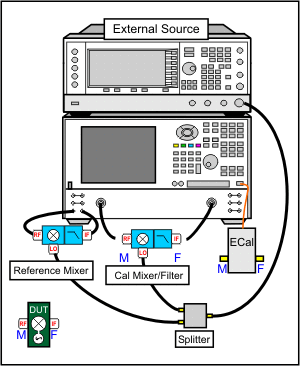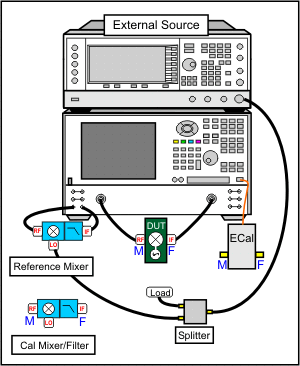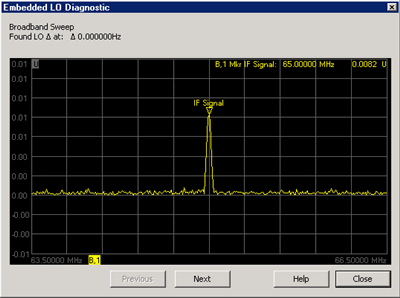
The Tuning Settings balance LO measurement speed versus accuracy.
You can see that accuracy is becoming compromised when noise starts
to appear on the measurement trace.
Scroll up to learn more about
the Embedded LO measurement process.
Enable Embedded LO Check
to enable measurement of the Embedded LO.
Tuning
Method These settings determine the amount of time spent
versus the degree of accuracy to which the LO Frequency is measured.
You can see that accuracy is becoming compromised when noise
starts to appear on the measurement trace.
Broadband
and Precise Does the entire tuning process for each background
sweep. See the Overview
for more information.
Precise
only Does NOT perform broadband tuning on each sweep.
Use this setting when the embedded LO is stable. The signal (after
broadband) must be within ½ the tuning IFBW. If the signal
will always be within ½ the IFBW, broadband tuning is not needed.
Most satellite components are within 3 kHz absolute so might not
need broadband tuning.
Disable
tuning Only the previously measured LO Frequency
Delta is applied to the reference mixer LO and VNA receivers.
Tuning Point Select,
or specify, the data point in the mixer sweep that will be used
to find the embedded LO frequency. If a marker is enabled, that
data point can be used. For broadband and Precise sweeps, choose
a point in the mixer sweep where noise is least likely to be found,
such as the point of highest gain. This is generally the center
of a sweep or the center of a filter if used.
Tune every Set
the interval at which tuning is performed before a measurement
sweep. 'Tune every 3 sweeps' means that every third measurement
sweep is preceded by tuning sweeps. If the embedded LO drifts,
or if regularly changing DUTs, use 'Tune every 1 sweep'.
Broadband
Search - Set the frequency span over which to measure
the embedded LO frequency.
IFBW IF Bandwidth
used for Broadband and Precise tuning sweeps. This sets the resolution
in the Broadband sweeps and sets the max error (1/2 IFBW) for
precise tuning. The larger the IFBW, the faster the sweep, but
the signal may not be found.
Max
Iterations The maximum number of Precise sweeps to
make. When this number is reached, the final measurement is used.
Tolerance
When two consecutive Precise measurements are made within
this value, the final measurement is used. If this is not achieved
within the Max Iterations value, then the last measurement is
used. This is the best of the 'Tunings settings' to change to
improve accuracy.
LO Frequency Delta The
absolute difference between the measured embedded LO frequency
and the LO setting that is entered in the Mixer
Setup dialog. This value is updated each time the embedded
LO frequency is measured. Entering a value is a way to change
the LO frequency on the mixer setup without invalidating the calibration.
Find Now
The VNA finds and measures the actual LO frequency using
the current dialog settings. This data is displayed in the Status box.
Status window Displays
textual and graphical representation of the Embedded LO measurement
sweeps.
Default Resets the LO Frequency
Delta and Tuning parameters to their default settings.
Graph...
Launches the graphical (spectrum analyzer type) display
sweeps of the latest embedded LO measurement.
|



